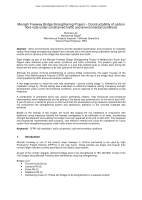Bridges

- Publication no: ABC2017-110-17
- Published: 26 April 2017
- PDF (free) Download
Strict environmental requirements and the standard specification and procedure for installing carbon fibre bridge strengthening system have naturally led to the works being undertaken during warmer months and on sections of the bridge that have been isolated from traffic.
Eight bridges as part of the Monash Freeway Bridge Strengthening Project in Melbourne’s South East Region were delivered under cold winter conditions and traffic constraints. The project’s goal was to deliver the works under night time lane closures in a way that enabled lanes to remain open during the works and the entire carriageway to be fully opened at the end of each shift.
Although the project involved strengthening of various bridge components, this paper focuses on the Carbon Fibre Reinforcement Polymer (CFRP) rod installation onto the top of the bridge deck, which was most impacted by traffic and environmental conditions.
A two stage process to install the rods was developed – groove cutting (stage 1), followed by the rod installation (stage 2). Off-site testing was undertaken to determine baseline setting time/epoxy strength development under current environmental conditions, and its response to the proposed additional curing measures.
A combination of preheated epoxy kits, groove preheating, heaters, heat enclosures and procedural improvements were implemented and full setting of the epoxy was achieved prior to the end of each shift. A pull-off test on a sacrificial groove on-site found that the accelerated curing measures implemented did not compromise the strengthening system and satisfactory adhesion to the concrete substrate was achieved.
Based on the findings of this project, we found that staging the rod installation in conjunction with additional curing measures allowed the freeway carriageway to be trafficable at all times, accelerating strength development and enabling the bridge to be fully reopened at the end of each shift. The measures and procedures implemented were practical, cost effective method and could be considered for future carbon fibre strengthening projects under traffic and/or environmental constraints.
